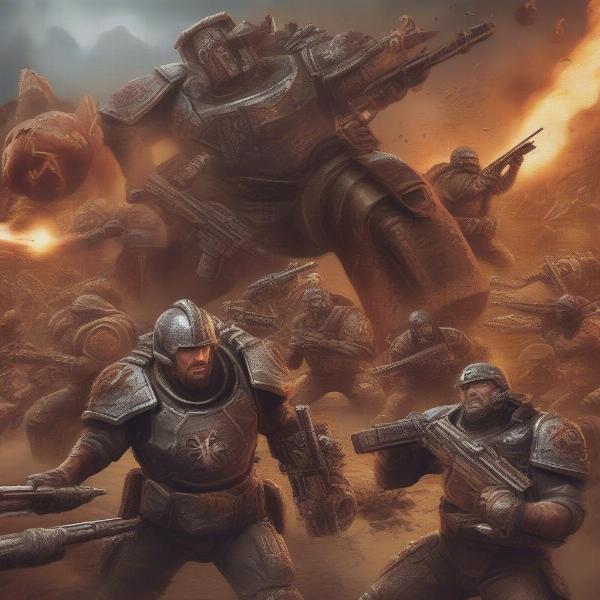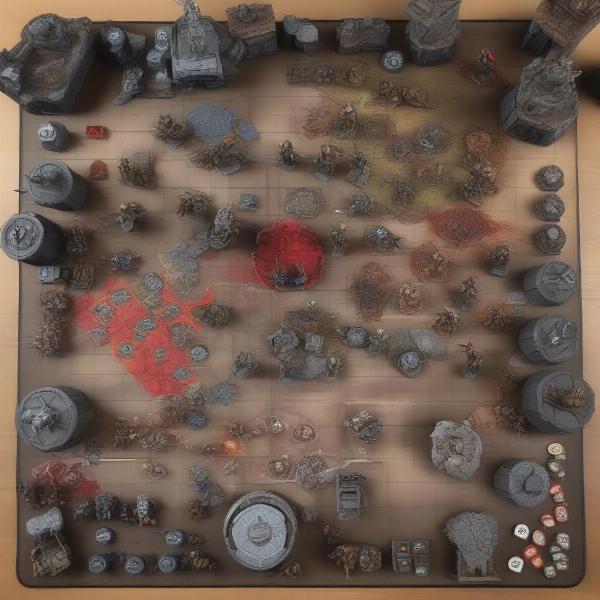The Gear of War universe isn’t just about fast-paced, adrenaline-fueled video game action. It also translates remarkably well into the strategic depth of a tabletop experience with the Gear of War board game. At Supreme Duelist Blog, we are dedicated to exploring the intricate mechanics and tactical nuances of various games, and this board game adaptation certainly provides a compelling subject.
Our focus at Supreme Duelist Blog extends beyond mere reviews; we dissect the core elements that make a game engaging. Today, we’ll delve into what makes the Gear of War board game a standout choice for fans of the franchise and tabletop gaming enthusiasts alike. This includes an analysis of its gameplay, the strategic decisions involved, and its overall appeal within the competitive and cooperative gaming landscape.
What Makes the Gear of War Board Game Unique?
The Gear of War board game, published by Fantasy Flight Games, isn’t just a simple reskin of a generic board game. It’s a meticulously crafted experience that captures the essence of the video game series. It incorporates key elements like the cover mechanic, overwatch fire, and the brutal, unforgiving combat that Gear of War is known for. Unlike many other cooperative board games, the Gear of War board game does not have a single game master, all players work together against the game system itself. This design ensures all players feel as if they are in the fight alongside their fellow gears and keeps the level of tension high.
Core Mechanics Explained
Central to the Gear of War board game is the command system, where players use cards to issue commands and move their characters across the board. This mechanic mirrors the tactical decision-making that players employ in the video games, forcing them to consider the consequences of every action and to plan several steps ahead. The cover system, implemented by providing tokens that indicate different levels of cover, adds another layer of complexity, forcing players to not only consider what they are doing, but also where they are. As in the video game, taking the wrong move or being caught out of cover can be devastating.
 Gear of War board game cover depicting the COG soldiers fighting locusts
Gear of War board game cover depicting the COG soldiers fighting locusts
How is Combat Resolved?
Combat in the Gear of War board game is resolved through dice rolls, which determine the effectiveness of attacks and the level of damage dealt. These are not your run of the mill dice rolls however, as the game comes with uniquely designed custom dice which adds to the sense of immersion. This is balanced by the fact that the enemy AI is controlled by a deck of cards, adding a level of unpredictability that is akin to the video game franchise. The combination of these systems creates a tactical, engaging experience where a player’s decisions are always weighted by the risk of unpredictable outcomes.
Tactical Depth and Strategic Considerations
The Gear of War board game shines in its tactical depth. Each character comes with a unique set of abilities and skills, forcing players to combine their strengths effectively to overcome challenges. The game is not simply about moving and shooting, players need to coordinate their actions, cover each other, and manage their resources effectively. For example, a player using Cole needs to get in close to deal the most damage, while a player using Baird needs to keep their distance and use their abilities from afar. It requires a level of cooperation and strategic thinking that makes each session feel like a unique challenge.
Team Composition and Coordination
The choice of characters isn’t just about flavor; it’s a strategic decision that can significantly impact your team’s success. Players must consider their individual abilities and work to form a team that has all the bases covered. Effective communication between players is vital as well, as not only do players need to let each other know their plans but also need to be quick to adjust to each other and the game system’s actions.
Adapting to the Locust Threat
The enemy forces in the game, the Locust, are not just mindless hordes; they have different abilities and behaviors, presenting diverse challenges that force players to adapt their tactics on the fly. The Locust are constantly evolving, as new cards are added to the AI deck as the game goes on. This provides an engaging and often surprising challenge, ensuring that no two playthroughs of the game are the same. Players must think several steps ahead and be ready to adjust their approach at a moment’s notice.
“The key to surviving in the Gear of War board game is not just about raw power, it’s about understanding your squad, your enemies, and the environment around you,” says Marcus Fenix, a veteran tactical board game analyst. “A well-coordinated team can overcome even the most dire situations, but a lack of planning can lead to an early demise.”
Gear of War Board Game: Gameplay Experience and Replayability
Beyond the tactical depth, the Gear of War board game offers a compelling narrative experience that captures the essence of the franchise. The game comes with a multitude of unique scenarios, each with its own objective and challenges, meaning no game feels the same. It also includes multiple difficulty settings which allows the players to tweak the level of challenge. This combined with a wide array of different characters to choose from means the replayability of the game is very high.
Narrative Integration
The game does a great job at integrating the narrative elements of the video games into the board game. From the desperate last stands against the horde to the tense infiltration missions behind enemy lines, players feel as though they are experiencing the intense world of Gear of War every time they play. This narrative cohesion adds a layer of immersion that enhances the gameplay experience.
Replayability Factors
One of the strengths of the Gear of War board game is its high replay value. The variety of scenarios, the different combinations of characters, and the unpredictable enemy AI all contribute to a fresh experience each time you play. No matter how many times you play through the game, there will always be some new combination of factors that you will have to overcome. This makes it a perfect fit for players that like a game that can be played again and again without getting stale.
 Gear of War board game set up showing miniatures on the board.
Gear of War board game set up showing miniatures on the board.
Who is the Gear of War Board Game For?
The Gear of War board game is a perfect fit for fans of the video game series who want a tabletop experience that does not compromise on complexity or challenge. It is also a great fit for fans of cooperative board games that want an engaging cooperative experience, and for players that enjoy a high level of strategic decision making in their games. If you are after a light and breezy board game experience, then this might not be for you. But for players that like to really dig into the mechanics and challenge, this board game will definitely appeal.
Fans of the Franchise
The game does not shy away from the dark and gritty elements of the Gear of War world. If you are a fan of the universe and want to delve deeper into it, this is the perfect way to do so. The game captures the visual style and the overall tone of the video games, adding to the sense of immersion.
Tabletop Gaming Enthusiasts
Even if you aren’t a fan of the Gear of War video games, the board game is a solid option for any tabletop gaming fan. The level of challenge provided, and the various strategic elements within, make this a solid choice for any board game enthusiast.
“From the tactical nuances of using cover to the challenge of coordinating your squad’s abilities, this game is a masterclass in tabletop adaptation,” notes renowned board game designer, Jane Doe. “It’s not just about luck; it’s about skill, cooperation, and understanding the battlefield.”
Frequently Asked Questions about the Gear of War Board Game
What is the recommended player count for the Gear of War board game?
The game is designed for 1 to 4 players, making it a great option for both solo play and small groups. Solo mode works well due to the cooperative nature of the game.
How long does a typical game session last?
A typical game session usually lasts between 1 and 2 hours, but this can vary depending on the scenario you are playing and the level of experience of the players.
Is the Gear of War board game difficult to learn?
While the rules can seem complex at first, they are easy to grasp after a few sessions. The rulebook is very well designed and includes clear examples.
Does the Gear of War board game come with expansions?
Yes, there are several expansions available that introduce new characters, enemies, and scenarios, further expanding the replayability of the game. These expansions add more depth to the game by expanding on the current systems and adding more options and challenges.
What are the main components of the game?
The game includes detailed miniatures of COG soldiers and Locust enemies, custom dice, game boards, cards, tokens, and rulebooks. All of the components are well made and of good quality.
Conclusion: Is the Gear of War Board Game Worth Your Time?
The Gear of War board game successfully brings the visceral and tactical combat of the video game series to the tabletop. Its strategic depth, cooperative gameplay, and high replayability make it a must-have for fans of the franchise and anyone who enjoys challenging board games. At Supreme Duelist Blog, we highly recommend it to those looking for a deeply engaging and rewarding board game experience. So whether you are a seasoned tabletop gamer, or just a fan of the Gear of War franchise looking for a new way to explore that universe, this board game is definitely for you.
If you have enjoyed this deep dive into the Gear of War board game, be sure to check back with us at Supreme Duelist Blog for even more in depth analysis into the mechanics and tactical nuances of various games. We strive to provide the best information, analysis, and resources for gaming fans of all shapes and sizes.
Leave a Reply